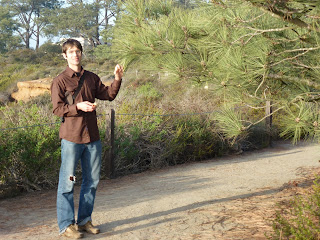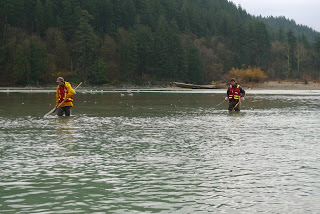For the last several years my family has
migrated south to California for the Holidays to take advantage of the warmer
weather and visit the more fecund family members who have difficulty traveling
with small children. Traditionally we
all loaded into the “Odious Whaler,” Mom’s red minivan so named for our normal
coastal route paralleling the Grey Whale migration and the repugnant odors that
result when a van full of car camping siblings eats too many Odwalla bars. Trips in the Odious Whaler where characterized by
Rambo camping (discovering hidden and free places to camp) and screeching
halts in Big Sur to identify shore birds, photograph elephant seals, race up
coastal trails, and to answer the whaler’s cry with raised binoculars.
This year, complex family schedules and
Mom’s reluctance to allow the aged “Oddie” her former freedom, forced Katrina and
to drive ourselves to our rendezvous in Ventura, CA. Our independence allowed us to extend our
trip considerably in order to take in the natural bounty of California. My primary goal was to harvest as many types
of acorns as possible, and Katrina—who has been more obsessed with salt lately—was keen to collect some salt from
some of the region's many natural deposits.
We packed our camping gear, binoculars, collecting bags, a back roads
atlas, and a few of our favorite ID books and planned a route that included the
Salton Sea, Joshua Tree National Park, the Grand Canyon, Death Valley, and
Yosemite.
 |
| Blue Oak (Quercus douglasii) silhouette |
We left Seattle on a frosty clear morning
driving hard for the potentially snowy Siskiyous in Southern
Oregon. We hoped to cross the pass
before dark and camp somewhere in Northern California. I wanted to explore the north end of the
Sacramento Valley for Valley Oaks (Quercus
lobata) because I have seen pictures of Valley Oak acorns so large that it
only took three to fill a hand. We
started seeing bare branched oak silhouettes in the fading light as we passed
through Redding and by the time we got to the small town of Cottonwood, I
couldn’t bear the thought of missing a collecting opportunity, so we pulled off
the highway on a lonesome exit and drove down a quiet dirt road until we found
a nice oak to sleep under. The stars
were twinkling brightly and the crescent moon had already set so we didn’t set
up the tent in order to enjoy the stars.
The next morning we were up at first light eager to stomp around and
warm up our cold bones (I thought we were in California!).
 |
| Variations in Blue Oak (Quercus douglasii) leaves |
 |
| Insect damaged Blue Oak Acorns |
 |
| Yuck! There isn't much left to eat. |
The oak we had slept under
didn’t have any acorns, but it didn’t take me long to find places with a heavy
mast of acorns lying on the ground. They
were about the size and shape of Garry Oak (Quercus
garryana) acorns with warty caps but the leaves were shallowly lobed or
entire. I think they may have been Blue
Oak (Quercus douglasii). Almost all of the acorns were damaged by
weevils so I did not collect any. One of
the reasons that Native Americans burned oak savannahs was to kill the weevil
larva, which spend 1-2 years buried in the leaf duff before pupating, and
searching out an acorn crib. Infected
acorns fall early, so a burn after they have fallen would serve the dual
purpose of limiting weevil reproduction, and clearing the vegetation below an
oak so that good acorns were easier to collect.
Klamath River Jack summarized this practice in a 1916 letter to the
California Fish and Wildlife Commission, “Fire burn up old acorn that fall on
ground. Old acorn on ground have lots
worm; no burn old acorn, no burn old bark, old leaves, bug and worms come more
every year…. Indian burn every year just same, so keep all ground clean, no
bark, no dead leaf, no old wood on ground, no old wood on brush, so no bug can
stay to eat leaf and no worm can stay to eat berry and acorn. Not much on ground to make hot fire so never
hurt big trees, where fire burn (In Kat Anderson’s Tending the Wild, 2005, p. 146).”
Continuing southward and downstream, we
soon left the savannah and entered the immense central valley grassland. What
John Muir once described as a “scene of peerless beauty” and an “ocean of
flowers” confronted us in half flooded rectangles of brown dirt rimmed with patches
of invasive Giant Reed Grass (Phragmites
sp.) Irrigation projects using Sacramento River
water have made this region a large producer of wild rice (Zizania palustris), a grain native to the Great Lakes region. While I am a fan of wild rice, it is sad to
see native ecosystems destroyed to grow a crop that flourishes with minimal
management in its own native habitat. We
pulled off the highway to investigate a paddy further and found ourselves on a
road to the Sacramento National Wildlife Refuge.
 |
| Northern Pintail |
The Sacramento National Wildlife Refuge
hosts 40 percent of the Pacific Flyway’s fleet of winter waterfowl. We followed the safari style automobile loop
through a portion of the 35,000 acre refuge and got good views of Cinnamon
Teal, Northern Pintail, Ruddy Ducks, White-fronted Geese, thousands of Snow
Geese, a Coomon Moorehen, and about 40 other species.
That evening we arrived at Jeremy’s house
and I met my new nephew who is still the size of a loaf of bread. Everybody else showed up the next day and I
spent the next few days on the beach teaching Christian how to build sand castles
and play bocce rock. The birding was
pretty good and I saw a Long-billed Curlew, several Marbled Godwits, and
learned to ID Black-bellied Plover in non-breading plumage and California
Towhees. We all went to the Griffith
Observatory one evening and learned a lot about space. I was really intrigued by a Foucault
Pendulum replica that is on display near the main door. It slowly turns clockwise relative to the
floor as it swings back and forth and in 1851, it was the first direct proof
that the earth is rotating on its axis (the earth rotates beneath the swinging
pendulum).
Pin It




















































